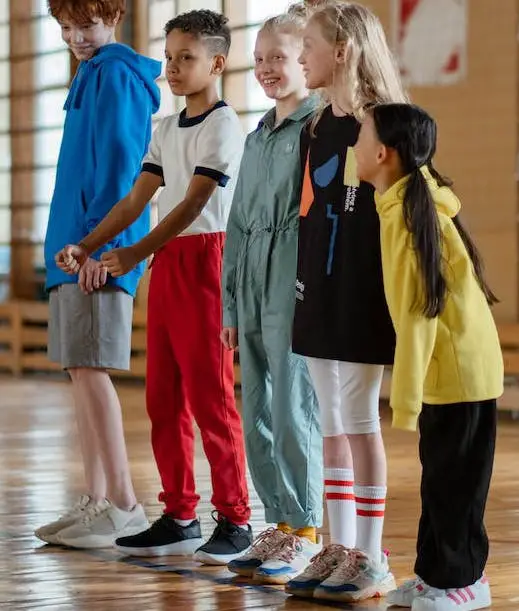Line Up chants are more than just catchy tunes; they are a harmonious blend of rhythm, discipline, and fun, designed to guide children through transitions and group activities with ease and enthusiasm.
In this comprehensive guide, we delve deep into the world of line up chants for kids. We explore their various types, from simple rhythmic chants that capture the essence of fun, to educational chants that cleverly weave learning into their verses. Interactive chants that engage children in call-and-response routines, and movement-based chants that combine physical activity with coordination, also feature prominently in our discussion.

Table of Contents
Introduction to Line Up Chants for Kids
Line up chants for kids are an innovative and effective strategy used primarily in educational and childcare settings to manage transitions and organize children in a fun, engaging way. These chants are short, rhythmic phrases or songs designed to smoothly transition kids from one activity to another, with a particular emphasis on lining up or moving from place to place.
The concept of line up chants is rooted in the understanding that children respond well to music, rhythm, and repetition. These elements, when combined, create a memorable and enjoyable experience that can turn potentially chaotic moments, like transitioning between activities or lining up for lunch, into smooth and orderly processes. The primary purpose of line up chants is to maintain order and discipline in a manner that is appealing to children, thus avoiding the common resistance or disorganization that can occur during such transitions.
Beyond just organization, line up chants offer several key benefits:
- Enhanced Listening Skills: As children listen and respond to the chant, they develop better listening and comprehension skills, which are critical in both academic and social settings.
- Improved Focus and Attention: The rhythm and repetition of the chants can help children focus their attention, teaching them to concentrate on instructions and follow them more effectively.
- Social Interaction and Cooperation: Participating in a group activity like a line up chant encourages cooperation among children. It’s a communal activity that requires them to work together, promoting a sense of unity and teamwork.
- Memory Development: Memorizing the words and actions of the chants can aid in developing a child’s memory capacity, an essential skill for academic success.
- Stress Reduction: The fun and interactive nature of these chants can significantly reduce stress and anxiety in children, particularly in situations where they might feel overwhelmed or restless.
- Cultural and Language Skills: For children in multilingual or multicultural environments, line up chants can be an excellent tool for introducing new languages or cultural elements in a playful and accessible way.
- Creativity and Expression: Encouraging children to participate in or even create their own line up chants fosters creativity and self-expression. It allows them to use their imagination and contribute their ideas, enhancing their sense of individuality and confidence.
In essence, line up chants are not just a tool for organization and discipline; they are a multifaceted educational resource that provides an array of developmental benefits. They blend the practical necessity of maintaining order with the intrinsic joy and engagement of music and rhythm, making them a valuable addition to any educational or childcare setting.
Types of Line Up Chants
Line up chants come in various forms and styles, each designed to cater to different needs and age groups. These chants are a mix of rhythm, words, and sometimes actions, making them a versatile tool in managing classroom transitions and enhancing learning experiences. Understanding the different types of line up chants can help educators and parents choose the most effective ones for their specific context.
- Simple Rhythmic Chants: These chants are characterized by their simplicity and repetitive nature. They often involve basic rhythms and are easy to remember, making them ideal for younger children or for settings where quick and straightforward transitions are needed. An example might be a simple counting chant or one that involves clapping or stomping to a certain beat.
- Educational Chants: Designed to be both fun and informative, educational chants incorporate learning elements into the chant. They might include basic math skills, such as counting, or language skills, like alphabet recognition. For instance, a chant might involve children reciting the alphabet or counting numbers in a rhythmic pattern as they line up.
- Interactive Chants: These chants require responses from the children, making them more engaging and participative. They often involve call-and-response patterns where the teacher says a line, and the children respond. This type of chant is excellent for keeping the children actively involved and ensuring they are paying attention.
- Movement-Based Chants: Some chants incorporate physical movements, such as clapping, stomping, or simple dance steps. These chants are particularly effective in not only organizing the children but also in helping them expend some energy and improve their motor skills.
- Thematic Chants: These are chants tailored to specific themes or subjects. For example, a science-themed chant might include references to planets or animals. Thematic chants are useful for reinforcing concepts taught in the classroom in a fun and memorable way.
- Multilingual Chants: In increasingly diverse educational settings, multilingual chants can be a valuable tool. These chants incorporate words or phrases from different languages, helping children appreciate and learn new languages and cultures.
- Customizable Chants: Some chants are designed to be easily customizable, allowing teachers or children to insert different words or phrases depending on the day or activity. This type of chant is great for keeping the routine fresh and adaptable.
- Storytelling Chants: These chants tell a short story or narrative, often culminating in the action of lining up or transitioning. They engage children’s imaginations and can be particularly captivating, making the transition time something to look forward to.
Each type of chant serves a unique purpose, from purely functional to educational and interactive. The key is to match the chant to the needs and interests of the children, as well as to the specific transition or activity at hand. By effectively utilizing these different types of line up chants, educators and parents can create a more dynamic, engaging, and orderly environment for children.
Examples of Simple Rhythmic Chants
Simple rhythmic chants are a cornerstone of effective classroom management, particularly useful for young children. These chants are characterized by their straightforward, repetitive rhythms and easy-to-remember lines. Below are some examples of simple rhythmic chants that can be used to help children line up or transition between activities.
- The Clap and Step Chant:cssCopy code
"Clap, clap, clap your hands, Step, step, step in line, Quiet now, it's lining up time, Let's make a line so fine."This chant incorporates clapping and stepping, making it engaging and easy for children to follow along. - The Counting Chant:scssCopy code
"One, two, three, four, Let's walk to the door. Five, six, seven, eight, Stand in line and wait."This chant uses simple counting to create a rhythm, helping children practice numbers while lining up. - The Whisper Chant:scssCopy code
"Whisper, whisper, nice and low, In the line, we quietly go. No loud sounds, just tiptoes light, We line up quiet and polite."This chant encourages quietness and gentle movement, ideal for times when maintaining a calm environment is necessary. - The Sunshine Chant:arduinoCopy code
"Shine, shine like the sun, Lining up can be fun. Smile wide and take your place, With sunshine on your face."A chant with a positive message, it encourages children to line up with a cheerful demeanor. - The Magic Line Chant:scssCopy code
"Magic line on the floor, Let’s line up at the door. Stand so tall, one by one, Ready now, we’re almost done."This chant introduces an element of imagination, making the act of lining up seem magical and appealing. - The Bubble Chant:scssCopy code
"Bubble in your mouth, hold it tight, Stand in line with all your might. No pops or sounds, just quiet feet, Standing in line is really neat."This chant uses the imagery of holding a bubble in the mouth to encourage silence and orderliness. - The Colorful Line Chant:scssCopy code
"Red, yellow, blue, and green, The quietest line that's ever been. Line up in colors bright, Ready to learn, with all our might."Introducing colors into the chant makes it visually engaging and can be used to teach or reinforce color recognition.
These simple rhythmic chants are not only tools for managing transitions but also opportunities for learning and engagement. The repetitive nature of the chants makes them easy for young children to memorize and enjoy, turning routine activities into fun, interactive moments. Teachers and caregivers can adapt these examples to fit their specific classroom needs or even involve children in creating their own unique chants.
Examples of Educational Chants
Educational chants are a creative and enjoyable way to integrate learning into daily routines, particularly in a classroom setting. These chants not only help in managing transitions but also serve as a tool for reinforcing academic concepts. Below are some examples of educational chants that incorporate elements of learning, such as language, math, and science concepts.
- The Alphabet Chant:
"A, B, C, D, line up with me, E, F, G, H, I, J, we’re on our way, K, L, M, N, O, P, in a line we go, Q, R, S, T, U, V, as quiet as can be, W, X, Y, and Z, now we’re ready, you see!"This chant helps children practice the alphabet in a fun and rhythmic way while lining up. - The Days of the Week Chant:
"Monday, Tuesday, time to line, Wednesday, Thursday, doing fine, Friday, Saturday, almost there, Sunday’s day of rest we share. Every day, we learn and play, Now in line, we’ll go our way."This chant incorporates the days of the week, making it a great tool for teaching the concept of time. - The Shape Parade Chant:
"Circle, square, triangle line, Rectangle, oval, stars that shine, Line up shapes, one by one, Shape parade is so much fun!"Ideal for teaching basic geometric shapes, this chant is both educational and catchy. - The Weather Watch Chant:
"Sunny, rainy, windy, or cold, In the line, we’re brave and bold. Weather changes, day by day, In our line, we’re okay!"This chant encourages children to observe and discuss the weather, integrating a science element into the daily routine. - The Counting by Tens Chant:
"Ten, twenty, thirty, line up neat, Forty, fifty, sixty, on our feet, Seventy, eighty, ninety, now, One hundred in line, take a bow."A chant that reinforces counting by tens, it’s perfect for developing early math skills. - The Healthy Habits Chant:
"Wash your hands, stand in line, Eating fruits and veggies is just fine. Exercise and rest so well, In our line, we feel swell!"This chant promotes healthy habits like hygiene, nutrition, and exercise. - The Color Mix Chant:
"Red and yellow make orange line, Blue and yellow, green so fine, Red and blue make purple bright, Colors in line, a beautiful sight!"Focused on color mixing, this chant is great for teaching basic concepts in art and color theory.
These educational chants are an effective way to reinforce learning in a lively and interactive manner. They not only aid in classroom management but also enrich the learning experience, making academic concepts memorable and engaging. Teachers can adapt these chants to align with the specific curriculum or learning objectives of their class, or even involve students in creating new educational chants.
Examples of Interactive Chants
Interactive chants are a dynamic way to engage children in a group activity, encouraging participation, listening, and response skills. These chants typically involve a call-and-response structure where the teacher says a line, and the children respond, making them ideal for fostering active participation and attention. Here are some examples:
- The Echo Line Up Chant:
Teacher: "When I say line, you say up" Children: "Up!" Teacher: "When I say quick, you say march" Children: "March!" Teacher: "Line up, line up, without a fuss" Children: "March, march, we’re lining up!"This chant uses the echo technique, where children repeat or respond to the teacher’s lines. - The Question and Answer Chant:
Teacher: "What’s the way we line up nice?" Children: "Quietly, without thinking twice!" Teacher: "How do we stand, side by side?" Children: "Straight and tall, with pride!"In this chant, the teacher asks questions, and the children respond with the correct behavior or action. - The Movement Instruction Chant:
"If I say jump, you jump up high, If I say low, touch the ground, don’t be shy. Now it’s time, let’s not roam, Jump up high and march to our classroom."This chant involves physical movements (like jumping or touching the ground) that children must follow, making it interactive and fun. - The Rhyme and Clap Chant:
Teacher: "I say a word, you rhyme when you line" Teacher: "Cat" Children: "Hat!" Teacher: "Sun" Children: "Fun!" Teacher: "Now we’re lined up, and it’s so fine" Children: "Lined up, right on time!"This chant incorporates rhyming and clapping, where children respond with a word that rhymes with the teacher’s word. - The Silly Sounds Chant:
Teacher: "When I say moo, you say baa" Children: "Baa!" Teacher: "When I say beep, you say boo" Children: "Boo!" Teacher: "Moo, beep, line up, let's go" Children: "Baa, boo, in a row!"This chant uses silly sounds for the call-and-response, making it fun and light-hearted. - The Imitation Chant:
"If I clap twice, you clap twice, If I stomp thrice, you stomp thrice. Follow my lead, let’s have some fun, Clap and stomp, then run, run, run!"Here, children imitate the teacher’s actions (like clapping or stomping), adding a physical element to the chant. - The Guessing Game Chant:
Teacher: "I’m thinking of a color that’s the sky" Children: "Blue!" Teacher: "I’m thinking of a number, one less than two" Children: "One!" Teacher: "You guessed it right, now in a line" Children: "We’re lining up, just in time!"This chant incorporates a guessing game where children respond to the teacher’s clues.
Interactive chants like these are not only fun but also significantly enhance children’s listening and cognitive skills. They create a lively atmosphere and make the process of lining up or transitioning between activities an enjoyable and engaging experience. Teachers can adapt these chants or create new ones to suit the specific needs and interests of their students, ensuring active participation and attention.
Examples of Movement-Based Chants
Movement-based chants are an excellent way to combine physical activity with classroom routines. These chants involve various movements like clapping, stomping, or simple dance steps, which help children in expending energy and improving coordination while also enjoying the process of lining up or transitioning. Here are some examples:
- The Clap and Stomp Chant:
"Clap, clap, clap your hands, three times with me, Stomp, stomp, stomp your feet, as loud as can be. Spin around, touch the ground, now take your seat, We’ve lined up so neatly, our chant is complete!"This chant incorporates clapping, stomping, spinning, and touching the ground, making it a full-body activity. - The Jump and Wiggle Chant:
"Jump up high, reach the sky, now wiggle to the door, Twist and turn, as we learn, then jump once more. Wiggle, wiggle, jump, and giggle, now in a straight line, Ready for class, all in a mass, looking so fine!"Including jumps, wiggles, twists, and turns, this chant is perfect for expending extra energy. - The Tip-Toe Quiet Chant:
"Tip-toe, tip-toe, quiet as a mouse, Move to the door, quiet as a house. No sounds, no peeps, as we go along, Tip-toe, tip-toe, silent as a song."Focused on tip-toeing, this chant promotes quiet movement and control. - The March and Count Chant:
"March in place, let’s keep the pace, one, two, three, four, Lift those knees, do it with ease, five, six, seven, more. Now march to the beat, with your little feet, all the way to eight, Lined up so great, we just can’t wait, learning is our fate!"This chant combines marching in place with counting, great for coordination and rhythm. - The Wave and Smile Chant:
"Wave your hands, smile so grand, as we line up today, Nod your head, as I’ve said, we’re ready to play. A wave, a smile, all the while, we line up in a row, Happy faces, to our places, together we go!"Incorporating waving and smiling, this chant is designed to be cheerful and uplifting. - The Spin and Freeze Chant:cssCopy code
"Spin around, don’t make a sound, then freeze in your spot, Stay so still, it’s a thrill, show us what you’ve got. Once you’ve frozen, pose chosen, now to the line, Quiet and calm, like a palm, doing just fine."A chant that involves spinning and freezing, great for control and balance. - The Hop and Stop Chant:
"Hop on one foot, then the other, like a bunny in a line, Hop, hop, hop, it's so sunny, in a straight line we align. When I say stop, you freeze on top, no more hops in store, Now we’re ready, steady and steady, for what the day has in store!"This chant is focused on hopping and then stopping, ideal for developing balance and listening skills.
Movement-based chants like these are not only effective for transition times but also provide a fun way for children to engage in physical activity, even within the confines of a classroom. These chants can be adapted to various age groups and can be modified to include different types of movements based on the children’s abilities and the space available.
How to Effectively Use Line Up Chants
Using line up chants effectively involves more than just reciting words to a rhythm. It’s about creating an atmosphere of participation, learning, and fun. Here are some additional strategies and considerations for effectively implementing line up chants in a classroom or childcare setting:
- Consistency is Key: Regular use of line up chants helps establish a routine. Children feel more secure and respond better when they know what to expect. Consistently using the same chant for specific transitions can be particularly effective.
- Involve Children in the Creation Process: Allowing children to contribute to the creation or modification of chants makes them more invested in the activity. It can be a creative exercise where they suggest words, actions, or even come up with an entirely new chant.
- Adjust According to Age and Development: The complexity and type of chant should align with the age and developmental stage of the children. For younger kids, simpler, more repetitive chants work best, while older children might enjoy more complex chants with educational elements.
- Use as a Teaching Tool: Line up chants can be an opportunity for informal learning. Incorporating elements like counting, vocabulary, or even foreign language phrases can turn a routine activity into a learning experience.
- Positive Reinforcement: Praise and positive reinforcement when children participate and follow the chant can be very encouraging. Highlighting good behavior or enthusiastic participation can motivate others to join in.
- Cultural Sensitivity: In diverse settings, it’s important to choose or create chants that are culturally inclusive. This can be an opportunity to celebrate different cultures and languages within the classroom.
- Incorporate Movement and Actions: Actions or simple dance moves can make chants more engaging. This also helps in burning off excess energy and improving coordination.
- Use as a Behavioral Management Tool: Chants can be a subtle way to manage classroom behavior. For example, using a quieter chant can help calm an over-energized group, while a more upbeat chant can be used to uplift a lethargic or disengaged group.
- Flexibility and Adaptation: Be prepared to adapt or change chants that aren’t working. Not all chants will be effective for every group, so flexibility is key.
- Integration with Classroom Themes: Chants can be integrated with current classroom themes or subjects. For example, if the class is learning about animals, chants incorporating animal sounds or names can be used.
- Feedback and Improvement: Regularly seek feedback from the children about which chants they enjoy and why. This feedback can be used to improve existing chants or to create new ones that better meet the children’s interests.
- Parental Involvement: Informing parents about the chants used in the classroom can encourage continuity at home. Parents can use similar chants for routines like bedtime or getting ready in the morning.
- Use of Technology: Incorporate technology by recording the chants or using apps that can play instrumental versions of the chants. This can add a new and exciting dimension to the activity.
- Seasonal and Special Occasions: Tailor chants to fit seasonal themes or special occasions like holidays, which can add a festive element to the routine.
By incorporating these strategies, line up chants become more than just a tool for transition; they transform into an enriching, educational, and enjoyable part of the day for children. The key is to be creative, flexible, and attentive to the needs and responses of the children, adapting the chants to suit the dynamics of the group.
FAQ
Can line up chants be used for different age groups?
Yes, line up chants can be adapted for various age groups. For younger children, simple and repetitive chants work best, while older kids might enjoy more complex chants with educational elements or challenges.
Can line up chants be used outside of school settings?
Absolutely! Line up chants can be effectively used at home, in daycare centers, or even during children’s group activities outside of school. They can help organize routines like meal times, bedtime, or preparing to leave the house.
How often should line up chants be changed or updated?
The frequency of changing or updating line up chants depends on the children’s response and interest. Some chants might remain effective for a long time, while others may need to be refreshed more regularly to maintain engagement.
See Related Posts

Gregorian Christmas Chants

Love Spell Chants

Best Softball Chants for U12

AKA Sorority Chants

Argentina Football Chants

Short Chants and Cheers

Alabama Football Chants

Everything to Know About African Chants

